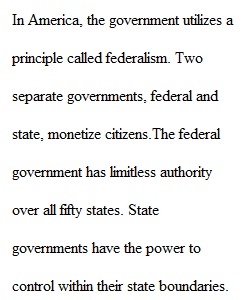


Q Instructions Purpose How powerful is a state? How powerful should it be? These questions have been debated since the Revolution. Under the Articles of Confederation, we saw states with significantly higher power than the national government; there was an attempt at more balance in the Constitution. Yet the debate over the power of each level of government continued to be debated, and this debate formed some of the reasoning behind having a Bill of Rights, led to the formation of our two political parties, and formed the basis of many of our conflicts in U.S. history. In the Federalist Era, we saw James Madison and Thomas Jefferson write the “Virginia and Kentucky Resolutions,” in reaction to the Alien and Sedition Acts; their work outlined their beliefs of where national law overreached and states should be able to counter that law. And in the Age of Jackson, we see the issue arise again in relation to the tariffs.
Q Task For this essay, you will need to read “Virginia and Kentucky Resolutions (1798)” (but please only read the Kentucky Resolution section) and “South Carolina Exposition and Protest”. In your essay, you should: 1. Write an introduction outlining the basic argument of state powers versus national powers. You may want to turn to the Constitution itself to find material. 2. Write a brief summary of why each document was written. What is the historical context of the documents? You will probably want a paragraph for each document. 3. Write a paragraph of what the two documents have in common. 4. Write a paragraph of what the difference in the two documents is. How does the “South Carolina Exposition and Protest” differ in its argument from the “Kentucky Resolution”? 5. Write a conclusion that answers whether or not a state should have the ability to nullify a national law, and if so, under what circumstances? If not, why not? This last paragraph will be your opinion, but remember do not use “I” in any form. State your opinion as if it were fact.
Q Expectations and Criteria for Success You should base your discussion with the information in the course content, though outside research is allowed if needed. DO NOT use Wikipedia as a source. As always, be sure to keep track of where you find your information so that you can provide citations in your final essay. Citations must be formatted according to the MLA guidelines, including both in-text and a final source page. Guidelines for MLA can be found using the Purdue Owl or you can reference the Citation Help.pdf from the Start Here Module of the course. Essays should be typed in 12-point font with a simple, clean font such as Times New Roman or Arial. Use 1" inch margins on all sides and double-space the text. Your essay should be around 1000 words.
Q Successful essays should be carefully organized, with strong thesis statements and specific evidentiary support. Your introduction should include a clear statement of what you will argue in the essay (thesis statements are never questions). The body of the essay will include at least three paragraphs (though you can write more – with this assignment, you will want four body paragraphs) that analyze and evaluate the idea of nullification. Conclude by discussing the key conclusion you reached and why (remember not to use the first person in formal academic essays). Be sure to revise and edit carefully. Click here to review the General Essay Guidelines included in your syllabus. Please remember you should submit documents as JPG, PDF, RTF, PNG, DOC and DOCX only. Other formats will not be accepted. Also, please ensure documents are submitted vertically and not horizontally. Incorrect submission formats could impact your grade. This activity may use a different grading rubric than what was used in past activities. Be sure to check the grading rubric before starting.
View Related Questions